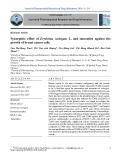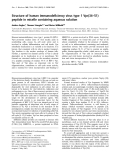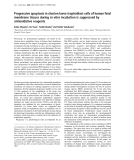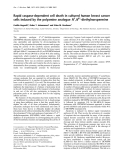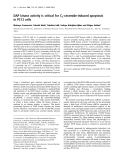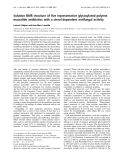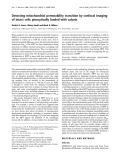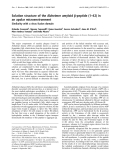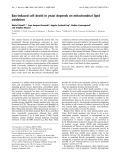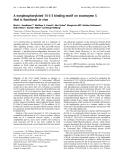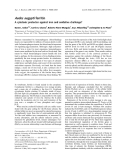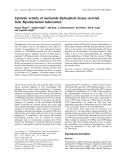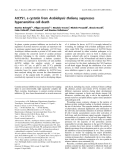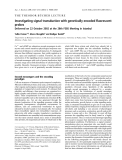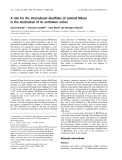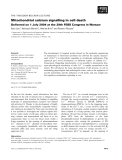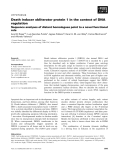
Cell death
-
Synergistic effect of Erythrina variegata L. and tamoxifen against the growth of breast cancer cells
Breast cancer is the most common malignancy and the second leading cause of death in women. While tamoxifen (TAM) remains to be a first-line agent for prevention and treatment of estrogenreceptor (ER) positive breast tumors, TAM resistance represents one of the biggest clinical challenges in breast cancer therapy.
 9p
9p  vihyuga
vihyuga
 04-03-2025
04-03-2025
 3
3
 1
1
 Download
Download
-
Human immunodeficiency virus type 1 protein R (HIV-1 Vpr) promotes nuclear entry of viral nucleic acids in nondividing cells, causes G2 cell cycle arrest and is involved in cellular differentiation and cell death. Vpr subcellular localization is as variable as its functions. It is known, that consistent with its role in nuclear transport, Vpr localizes to the nuclear envelope of human cells. Further, a reported ion channel activity of Vpr is clearly dependent on its localization in or at membranes.
 6p
6p  system191
system191
 01-06-2013
01-06-2013
 39
39
 4
4
 Download
Download
-
Previously, we demonstrated apoptotic cell death in the chorion laeve trophoblast layer of human fetal membrane tissues during the late stages of pregnancy, the progression of apoptosis during incubation in vitro, and its suppression by a low concentration of glucocorticoid hormones.
 8p
8p  system191
system191
 01-06-2013
01-06-2013
 38
38
 5
5
 Download
Download
-
Subunits (a, b and c) of the interleukin-2 receptor complex (IL-2R) are involved in both proliferative and activationinduced cell death (AICD) signaling of T cells. In addition, the signaling b and c chains are shared by other cytokines (e.g. IL-7, IL-9, IL-15). However, the molecular mechanisms responsible for recruiting/sorting the a chains to the signaling chains at the cell surface are not clear.
 10p
10p  research12
research12
 01-06-2013
01-06-2013
 33
33
 5
5
 Download
Download
-
The spermine analogue N1,N11-diethylnorspermine (DENSPM) efficiently depletes the cellular pools of putrescine, spermidine and spermine by down-regulating the activity of the polyamine biosynthetic enzymes and up-regulating the activity of the catabolic enzyme spermidine/ spermine N1-acetyltransferase (SSAT). In the breast cancer cell line L56Br-C1, treatment with 10 lM DENSPM induced SSAT activity 60 and 240-fold at 24 and 48 h after seeding, respectively, which resulted in polyamine depletion. ...
 7p
7p  research12
research12
 01-06-2013
01-06-2013
 58
58
 5
5
 Download
Download
-
Exposure of PC12 cells to C2 -ceramide results in dose-dependent apoptosis. Here, we investigate the involvement of death-associated protein (DAP) kinase, initially identi®ed as a positive mediator of the interferon-c-induced apoptosis ofHeLa cells, in theC2-ceramide-inducedapoptosis of PC12 cells.DAPkinase isendogenouslyexpressedinthesecells.
 9p
9p  research12
research12
 29-04-2013
29-04-2013
 35
35
 2
2
 Download
Download
-
Glycosylatedpolyenemacrolide antibiotics, as nystatins and amphotericins, are amphiphilic structures known to exert antifungal activity by disrupting the fungal cell membrane, leading to leakage of cellular materials, and cell death. This membrane disruption is strongly influenced by the presence and the exact nature of the membrane sterols.
 9p
9p  research12
research12
 23-04-2013
23-04-2013
 39
39
 2
2
 Download
Download
-
When studiedin vitro, mitochondrial permeability transition (MPT) is associated with an increase in mitochondrial per-meability to solutes up to 1500 Da in mass and a loss of electrical potential difference across the inner mitochondrial membrane (Dwmit). The MPT has been implicated as being important in cellular calcium homeostasis, autophagy and cell death via necrosis and apoptosis.
 8p
8p  research12
research12
 23-04-2013
23-04-2013
 48
48
 3
3
 Download
Download
-
Insect pests and pathogens (fungi, bacteria and viruses) are responsible for severe crop losses. Insects feed directly on the plant tissues, while the pathogens lead to damage or death of the plant. Plants have evolved a certain degree of resistance through the production of defence compounds, which may be aproteic, e.g. antibiotics, alkaloids, terpenes, cyanogenic glucosides or proteic, e.g. chitinases,b-1,3-glu-canases, lectins, arcelins, vicilins, systemins and enzyme inhibitors.
 16p
16p  research12
research12
 23-04-2013
23-04-2013
 46
46
 3
3
 Download
Download
-
The major components of neuritic plaques found in Alzheimer disease (AD) are peptides known as amyloid b-peptides (Ab),which derive from the proteolitic cleavage of theamyloidprecursorproteins.InvitroAbmayundergoa conformational transition from a soluble form to aggrega-ted,fibrillary b-sheet structures,which seem to be neuro-toxic. Alternatively,it has been suggested that ana-helical form can be involved in a process of membrane poration, which would then trigger cellular death.
 7p
7p  tumor12
tumor12
 22-04-2013
22-04-2013
 39
39
 2
2
 Download
Download
-
The oxidant function of pro-apoptotic protein Bax was investigated through heterologous expression in yeast. Direct measurements of fatty acid content show that Bax-expression induces oxidation of mitochondrial lipids. This effect is prevented by the coexpression of Bcl-xL. The oxi-dation actually could be followed on isolated mitochondria as respiration-induced peroxidation of polyunsaturatedcis-parinaric acid and on whole cells as the increase in the amount of thiobarbituric acid-reactiveproducts. ...
 11p
11p  tumor12
tumor12
 22-04-2013
22-04-2013
 43
43
 2
2
 Download
Download
-
14-3-3 proteins play an important role in a multitude of signalling pathways. The interactions between 14-3-3 and other signalling proteins, such as Raf and KSR (kinase suppressor of Ras), occur in a phospho-specific manner. Recently, a phosphorylation-independent interaction has been reported to occur between 14-3-3 and several proteins, for example 5-phosphatase, p75NTR-associated cell death executor (NADE) and the bacterial toxin Exoenzyme S (ExoS), an ADP-ribosyltransferase from Pseudomonas aeruginosa. ...
 9p
9p  tumor12
tumor12
 22-04-2013
22-04-2013
 32
32
 3
3
 Download
Download
-
Exposure of mammalian cells to oxidant stress causes early (iron catalysed) lysosomal rupture followed by apoptosis or necrosis. Enhanced intracellular production of reactive oxygen species (ROS), presumably of mitochondrial origin, is also observed when cells are exposed to nonoxidant pro-apoptotic agonists of cell death. We hypothesized that ROS generation in this latter case might promote the apoptotic cascade and could arise from effects of released lysosomal materials on mitochondria.
 9p
9p  tumor12
tumor12
 20-04-2013
20-04-2013
 34
34
 1
1
 Download
Download
-
Báo cáo khoa học: Aedes aegypti ferritin A cytotoxic protector against iron and oxidative challenge?
Diseases transmitted by hematophagous (blood-feeding) insects are responsible for millions of human deaths world-wide. Inhematophagous insects, thebloodmeal is important for regulating egg maturation. Although a high concentra-tion of iron is toxic for most organisms, hematophagous insects seemunaffectedby the iron load inabloodmeal.One means by which hematophagous insects handle this iron load is, perhaps, by the expression of iron-binding proteins, specifically the iron storage protein ferritin....
 8p
8p  tumor12
tumor12
 20-04-2013
20-04-2013
 47
47
 4
4
 Download
Download
-
Pathogenicity ofMycobacterium tuberculosisis closely rela-ted to its ability to survive and replicate in the hostile envi-ronment of macrophages. For some pathogenic bacteria, secretion of ATP-utilizing enzymes into the extracellular environment aids in pathogen survival via P2Z receptor-mediated, ATP-induced death of infected macrophages. A component of these enzymes is nucleoside diphosphate kinase (Ndk). Thendkgenewas cloned fromM. tuberculosis H37Rv and expressed inEscherichia coli.
 10p
10p  tumor12
tumor12
 20-04-2013
20-04-2013
 44
44
 4
4
 Download
Download
-
Báo cáo khoa học: AtCYS1, a cystatin from Arabidopsis thaliana, suppresses hypersensitive cell death
In plants, cysteine protease inhibitors are involved in the regulation of protein turnover and play an important role in resistance against insects and pathogens. AtCYS1from Arabidopsis thalianaencodes a protein of 102 amino acids that contains the conserved motif of cysteine protease inhibitors belonging to the cystatin superfamily (Gln-Val-Val-Ala-Gly). Recombinant A. thaliana cystatin-1 (AtCYS1) was expressed in Escherichia coliand purified.
 12p
12p  fptmusic
fptmusic
 16-04-2013
16-04-2013
 25
25
 3
3
 Download
Download
-
Ca 2+ and cAMP are ubiquitous second messengers in euk-aryotes and control numerous physiological responses ran-ging fromfertilization to cell death induction 1 . Todistinguish between these different responses, their subtle regulation in time, space and amplitude is needed. Therefore, the char-acterization of the signalling process requires measurement of secondmessengers with tools of precise localization, high dynamic range and as little disturbance of cell physiology as possible.
 10p
10p  fptmusic
fptmusic
 16-04-2013
16-04-2013
 42
42
 4
4
 Download
Download
-
The dimeric structure of seminal ribonuclease (BS-RNase) is maintained by noncovalent interactions and by two intersubunit disulfide bridges.Another unusual feature of this enzyme is its antitumour action, consisting in a cyto-toxic activity selective for malignant cells.This cytotoxic action is exerted when the protein reaches the cytosol of the affected cells, where it degrades ribosomal RNA, thus blocking protein synthesis and leading cells to death.
 8p
8p  fptmusic
fptmusic
 16-04-2013
16-04-2013
 42
42
 2
2
 Download
Download
-
The development of targeted probes (based on the molecular engineering of luminescent or fluorescent proteins) has allowed the specific measure-ment of [Ca 2+ ] in intracellular organelles or cytoplasmic subdomains. This approach gave novel information on different aspects of cellular Ca 2+ homeostasis. Regarding mitochondria, it was possible to demonstrate that, upon physiological stimulation of cells, Ca 2+ is rapidly accumulated in the matrix.
 10p
10p  fptmusic
fptmusic
 11-04-2013
11-04-2013
 42
42
 2
2
 Download
Download
-
Death inducer obliterator protein 1 [DIDO1; also termed DIO-1 and death-associated transcription factor 1 (DATF-1)] is encoded by a gene thus far described only in higher vertebrates. Current gene ontology descriptions for this gene assign its function to an apoptosis-related pro-cess. The protein presents distinct splice variants and is distributed ubiqui-tously.
 7p
7p  fptmusic
fptmusic
 11-04-2013
11-04-2013
 40
40
 2
2
 Download
Download
CHỦ ĐỀ BẠN MUỐN TÌM








